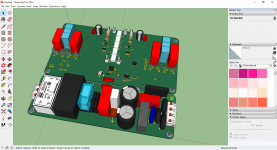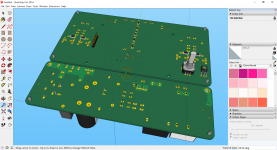It’s the Gamaxx 300. I bought mine from eBay but those links are all $30 to $35 now. Here is the lowest priced one I could find now $15. I got mine for $12 at one point. They seem to be well reviewed and rated if you look around. They certainly can cool MOSFETs like no one’s business. Rate up to 130w bit that may mean a faster running fan. I have mine on the slowest setting and the trim pot on the PWM board on slowest setting.
Deepcool Gammaxx 300 Cpu Cooler 120Mm Pwm Fan
Good to hear that you have a solid now noise system now. If your speaker returns go to the PSU then there is not much going through the 0v tab to the PCB. So 1w should be fine.
Deepcool Gammaxx 300 Cpu Cooler 120Mm Pwm Fan
Good to hear that you have a solid now noise system now. If your speaker returns go to the PSU then there is not much going through the 0v tab to the PCB. So 1w should be fine.
Last edited:
Going mono will certainly make it easier to move about. Since you guys have had yours working for a while, I am curious what PS caps you went with. Previous builds for me have been on the high end Mundorf and on the low end some no name. One of the vendors here on DIY has 15k uf @ 63v for $4 ea.
Basically any sonic differences noticed?
Thanks
David
Basically any sonic differences noticed?
Thanks
David
Big caps on PSU CRC I use lowest price caps with correct rating. Usually 22mF or 33mF CDE brand 85C. Minimum 35v rating for B.B. but 50v probably better. They run between $4.5 to $6. Low ESR caps help reduce ripple of course. My current B.B. setup is 4x22mF 35v CDE in CRC with 2x0.22R 3w Panasonic ERX. This is followed by a 4x10mF 50v CDE CRC also 2x 0.22R 3w ERX in parallel. It’s just what I happen to have on hand so I used it. I think if I sat down and designed one in LTSpice it would probably be a CRCLC and use all 33mF caps.
I have learned so much with this build and this topic, even though it's quite simple build. But maybe that's only a good thing to get know about basics.
JPS64, are you still planning to do that stand alone Vu-meter - project? That would make really nice visuals for Alpha and B.B.
I'm a little scared that I drive Alpha over it's limits, since those JBL's can take hundreds of watts, would be nice to know when reaching the limits.
JPS64, are you still planning to do that stand alone Vu-meter - project? That would make really nice visuals for Alpha and B.B.
I'm a little scared that I drive Alpha over it's limits, since those JBL's can take hundreds of watts, would be nice to know when reaching the limits.
Last edited:
Very busy professionally, I´ve find some time to progress with the universal microcontroller based VU-METER.
I´ll use following E-Ink display:
400x300, 4.2inch E-Ink display module, three-color, SPI interface
MMI is to be defined but thinking about alarms, dB VU-METER , FFT and more.
The attached three schematics include two parts:
- the +5V analog AC/DC converter, the +12V digital (PWM) AC/DC converter, the DC blocking and the inrush current limiter: works with 115VAC or 230VAC
and
- the stereo VU-METER electronic sensig loudspeaker level: potentiometer settings 0dB before clipping; the ground is the analog ground therefore isolated from digital ground
- relay attenuator controlled by microcontroller using PEC11 encoder as volume control
- IR remote control
- ALPHA BB stereo PWM I2C interface with temperature control and +12V digital power referenced to digital ground
- DC power relays switches (R/L) controlled by microcontroller
- microcontroller with USB interface and bootloader
First step: finishing layout and ordering first prototype for software programming.
I´ll put the schematics and all datas online for check before ordering.
Comments are welcome!!!
Yes, I´m using SMD components.
PCB is 4 layers (using also for AC part creepage rules of innerlayers).
Find first 3D view attached (missing E-Ink display).
JP
I´ll use following E-Ink display:
400x300, 4.2inch E-Ink display module, three-color, SPI interface
MMI is to be defined but thinking about alarms, dB VU-METER , FFT and more.
The attached three schematics include two parts:
- the +5V analog AC/DC converter, the +12V digital (PWM) AC/DC converter, the DC blocking and the inrush current limiter: works with 115VAC or 230VAC
and
- the stereo VU-METER electronic sensig loudspeaker level: potentiometer settings 0dB before clipping; the ground is the analog ground therefore isolated from digital ground
- relay attenuator controlled by microcontroller using PEC11 encoder as volume control
- IR remote control
- ALPHA BB stereo PWM I2C interface with temperature control and +12V digital power referenced to digital ground
- DC power relays switches (R/L) controlled by microcontroller
- microcontroller with USB interface and bootloader
First step: finishing layout and ordering first prototype for software programming.
I´ll put the schematics and all datas online for check before ordering.
Comments are welcome!!!
Yes, I´m using SMD components.
PCB is 4 layers (using also for AC part creepage rules of innerlayers).
Find first 3D view attached (missing E-Ink display).
JP
Attachments
Jean-Paul,
This is brilliant. I don't even fully yet understand what you have supplied here, but certainly it offers a huge array of control and metering functions that even a highly sophisticated amp in the $50k range uses!
Thank you very much, this is very, very kind of you - not to mention the high level engineering in all these functions.
Hugh
This is brilliant. I don't even fully yet understand what you have supplied here, but certainly it offers a huge array of control and metering functions that even a highly sophisticated amp in the $50k range uses!
Thank you very much, this is very, very kind of you - not to mention the high level engineering in all these functions.
Hugh
Last edited:
Here schematics.
Perhaps some filtering at AC/DC outputs?
Comments welcome.
JP
Very nice JP! I like the 0.1% 15ppm resistors used for the stepped relay volume control. We can expect the best channel matching here. Can you explain how it works because I see the 6 relays and each has 2 positions. I would have assumed one position is simple NC but it switches to a different value - are you getting 12bit resolution with this method vs 6bits(64 steps)?
We might want to put the rotary encoder and IR on a cable to make placement flexible. Although I see what you have allows the whole thing to be mounted on front panel and have a window for ePaper display. Will rotary encoder also have push momentary action for menu selection? Or maybe add a few push buttons for menu and leave knob purely for volume all the time.
Thank you. This is going to be make a very nice addition to any high-end ultimate end game amp.

Very busy professionally, I´ve find some time to progress with the universal microcontroller based VU-METER.
I´ll use following E-Ink display:
400x300, 4.2inch E-Ink display module, three-color, SPI interface
MMI is to be defined but thinking about alarms, dB VU-METER , FFT and more.
The attached three schematics include two parts:
- the +5V analog AC/DC converter, the +12V digital (PWM) AC/DC converter, the DC blocking and the inrush current limiter: works with 115VAC or 230VAC
and
- the stereo VU-METER electronic sensig loudspeaker level: potentiometer settings 0dB before clipping; the ground is the analog ground therefore isolated from digital ground
- relay attenuator controlled by microcontroller using PEC11 encoder as volume control
- IR remote control
- ALPHA BB stereo PWM I2C interface with temperature control and +12V digital power referenced to digital ground
- DC power relays switches (R/L) controlled by microcontroller
- microcontroller with USB interface and bootloader
First step: finishing layout and ordering first prototype for software programming.
I´ll put the schematics and all datas online for check before ordering.
Comments are welcome!!!
Yes, I´m using SMD components.
PCB is 4 layers (using also for AC part creepage rules of innerlayers).
Find first 3D view attached (missing E-Ink display).
JP
Woooooww perfect
I think it would be sonically more pure, to modify the input stage to accept balanced inputs than to add what is tantamount to two opamps inside a THAT 1200 in the signal path. Hugh would have to tell us how to go about the surgery, but my guess is we replace the feedback shunt cap with the negative phase input from the balanced source. Both input resistors would have to be the same value (820R).
I think it would be sonically more pure, to modify the input stage to accept balanced inputs than to add what is tantamount to two opamps inside a THAT 1200 in the signal path. Hugh would have to tell us how to go about the surgery, but my guess is we replace the feedback shunt cap with the negative phase input from the balanced source. Both input resistors would have to be the same value (820R).
Yes, I guess. I know NP does it on some of his DIY designs and it would be great addition.
Do
pinnocchio
I too would like to have balanced inputs on my alpha 20's. Asked X that question and he replied in post 1091 with mods to the pcb. My thought was to pm Hugh and ask him to post an image of the board showing the changes needed. I have seen your posts on Quebecdiy and hope I can ask you questions during the build.
I too would like to have balanced inputs on my alpha 20's. Asked X that question and he replied in post 1091 with mods to the pcb. My thought was to pm Hugh and ask him to post an image of the board showing the changes needed. I have seen your posts on Quebecdiy and hope I can ask you questions during the build.
pinnocchio
I too would like to have balanced inputs on my alpha 20's. Asked X that question and he replied in post 1091 with mods to the pcb. My thought was to pm Hugh and ask him to post an image of the board showing the changes needed. I have seen your posts on Quebecdiy and hope I can ask you questions during the build.
Hi Jazzfan,
My request was more to integrate directly on the BB since JP is working on the layout. Not crucial but a welcome feature nonetheless...
I have not yet started a thread on QuebecDIY but will most likely do so once I start my build.
All the best!
Do
My request was more to integrate directly on the BB since JP is working on the layout. Not crucial but a welcome feature nonetheless...
BB is all done and just shipped from factory today, will arrive in US in 5 days. It has no provisions in layout for balanced input.
- Home
- Amplifiers
- Solid State
- Aksa Lender P-MOS Hybrid Aleph (ALPHA) Amplifier

